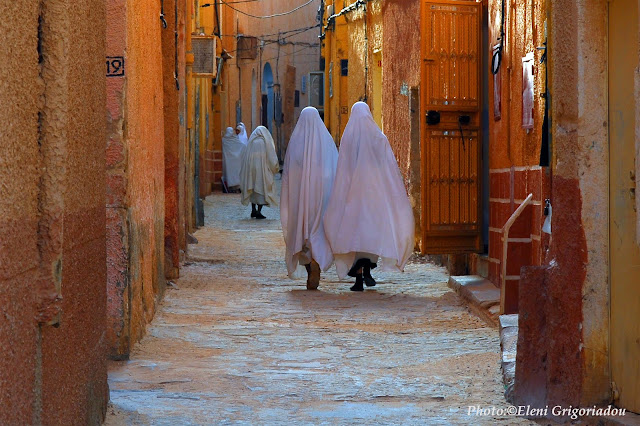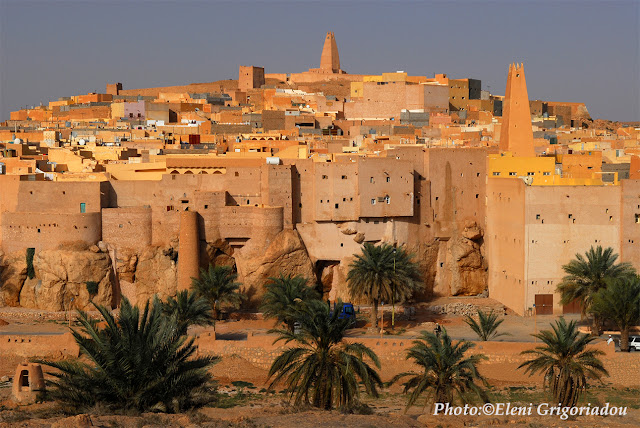The women of the Mozabite, from the Ghardaia region, belong to the Kharidjites, a distinctive sect of Islam. The uniqueness of this group is that it is imperative that the woman receives training in religion, so she has the advantage of knowing her Muslim rights and has the right to defend herself.
The Mozabite people also called the Ibadites, are a Berber ethnic group inhabiting the M'zab natural region in the northern Sahara in Algeria, in the tenth century, and their descendents still inhabit the towns today.
Mozabites are sunnite Muslims, of the ibadite rite, from its founder, Abdullah Ibn Ibad. Ibadite faith is an indissociable part of all other sunnite schools, namely Malekit. They are recognized by their traditional costume of saroual loubia (baggy trousers) and chechia (head gear).
Mozabites live in five oases; namely, Ghardaïa, Beni Isguen, El Atteuf, Melika and Bounoura, as well as two other isolated oases farther north: Berriane and Guerrara. The fortified villages, known as ksour, are built on rocky outcroppings and designed to make the most of their defensive locations and fortifications.
Life in Mozabite towns is governed by rules that are strictly observed by all. All inhabitants, including those with business outside of the town, contribute to the maintenance and care of the community. Conservative Mozabites keep their women jealously hidden away. House terraces openings are designed to allow women to see the outside world without being seen.
The Mozabites are peculiar in several respects. They represcents a small Berber island n a vast Arab sea. They are the only city-dwellers in the Sahara. They practice a fierce and exclusive form of Islamic puritanism, not unlike that of the Wahabi of Arabia, but in an urban and not a tribal frame of society and they have kept their institutions intact, only giving up their political status as independent republics and becoming part of the territory of Algerian France.
The five ancient fortified towns of the M'zab area, also known as the Pentapolis, have been designated a UNESCO World Heritage Site in 1982, as an example of a traditional human habitation that is perfectly adapted to its surrounding environment with a city structure designed to support family life.
Beni Isguen: This 14th-century town is one of Algeria’s most fascinating. Traditional ways are strictly adhered to. Local women, who are draped in white shawls from head to toe, are allowed to have only one eye showing. Men and women lead completely segregated lives, and each gender has its own council
Beni Isguen: This 14th-century town is one of Algeria’s most fascinating. Traditional ways are strictly adhered to. Local women, who are draped in white shawls from head to toe, are allowed to have only one eye showing. Men and women lead completely segregated lives, and each gender has its own council











